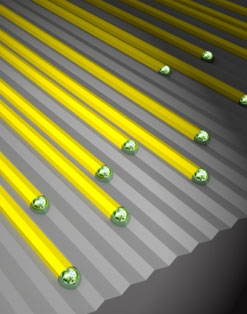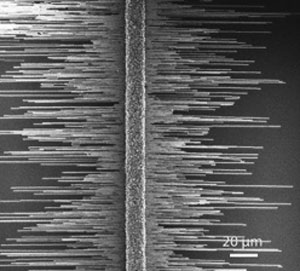| Aug 22, 2011 |
Nanowires get into the groove
|
|
(Nanowerk News) Growing up is not easy, especially for tiny nanowires: With no support or guidance, nanowires become unruly, making it difficult to harness their full potential as effective semiconductors. Prof. Ernesto Joselevich of the Weizmann Institute's Chemistry Faculty has found a way to grow semiconductor nanowires out, not up, on a surface, providing, for the first time, the much-needed guidance to produce relatively long, orderly, aligned structures. Since semiconductors with controlled structures are at the core of the most advanced technologies, this new research will hopefully enable the production of semiconductor nanostructures with enhanced electronic and optical properties, suitable for a wide range of applications including LEDs, lasers, information storage media, transistors, computers, photovoltaics and more.
|
 |
| Illustration of nanowires growing along nanogrooves.
|
|
Joselevich, Ph.D. student David Tsivion and postdoctoral fellow Mark Schvartzman of the Materials and Interfaces Department grew nanowires made of gallium nitride (GaN) using a method that usually produces vertical nanowires with excellent optical and electronic properties. These vertical wires only become unruly once they are harvested and assembled into arrays. To bypass this problem, the scientists used sapphire as a base on which to grow the nanowires. But rather than growing them on a smooth surface, they deliberately cut the sapphire along different planes of the crystal, resulting in various surface patterns including "steps" of nanometer dimensions between the different planes, as well as accordion-like, V-shaped grooves.
|
|
Their results, recently published in Science ("Top view of the nanowires by scanning electron microscopy (SEM)"), show that surface steps and grooves have a strong guiding effect, coaxing the nanowires to grow horizontally along their edges or within the grooves and producing well-aligned, millimeter-long nanowire arrays. In contrast, current methods of assembling nanowires horizontally on smooth surfaces result in disorderly nanowires only micrometers in length with subpar properties.
|
|
Joselevich: "It was surprising to discover that the optical and electronic properties of our nanowires were just as good – if not better – than those grown vertically, because growing semiconductors on a surface usually introduces defects that degrade their quality."
|
 |
| Top view of the nanowires by scanning electron microscopy (SEM).
|
|
Although it is still not fully clear how a method that normally produces vertical nanowires works to create horizontal growth in the new study, Joselevich and his team have managed to combine, in a single step, the synthesis and assembly of well-structured nanowires with unique properties suitable for a wide range of applications, by simply getting them "into the groove."
|


